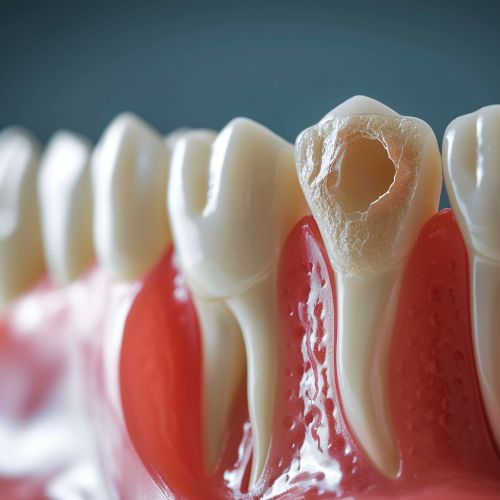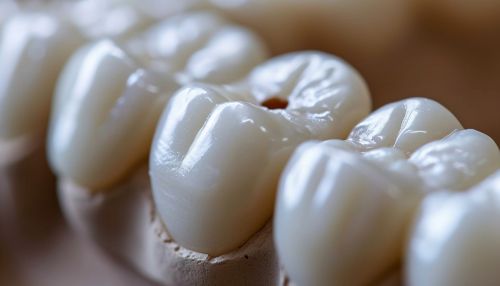Dental caries
Definition and Overview
Dental caries, also known as tooth decay or cavities, is a common oral health disorder characterized by the localized destruction of the hard tissues of the teeth. It is caused by the metabolic activities of specific bacteria that reside in the dental plaque, a biofilm that accumulates on the teeth. These bacteria metabolize dietary sugars to produce acids that demineralize the tooth enamel and dentin, leading to the formation of carious lesions.
Etiology
The etiology of dental caries involves a complex interplay of multiple factors, including the host (the individual's teeth and saliva), the oral microbiota, the diet, and time. The primary causative agents of dental caries are acidogenic and aciduric bacteria, particularly Streptococcus mutans and Lactobacillus species. These bacteria are capable of adhering to the tooth surface and forming a biofilm, and they metabolize dietary carbohydrates, especially sugars, to produce lactic acid. The acid lowers the pH in the plaque, leading to the demineralization of the tooth enamel and dentin.
Pathogenesis
The pathogenesis of dental caries involves two main processes: demineralization and remineralization. Demineralization occurs when the pH in the plaque drops below the critical level (approximately 5.5 for enamel and 6.2 for dentin), leading to the dissolution of the mineral content of the tooth. This is followed by a period of remineralization, during which the tooth can recover some of the lost minerals from the saliva and the plaque fluid. The balance between these two processes determines whether a carious lesion will progress or regress.
Clinical Manifestations
The clinical manifestations of dental caries vary depending on the stage of the disease. In the early stages, caries may present as white spots on the enamel surface, which are areas of demineralization. As the disease progresses, the enamel surface may break down to form a cavity, which can be detected visually or with the use of a dental explorer. If the caries reaches the dentin, the patient may experience sensitivity to temperature changes or sweet foods. In advanced stages, caries can lead to severe toothache, abscess formation, and even tooth loss.
Diagnosis
The diagnosis of dental caries is based on a clinical examination, which may be supplemented by radiographic examinations. The clinical examination involves visual inspection of the teeth and the use of a dental explorer to detect soft areas in the tooth surface. Radiographs, such as bitewing radiographs, can reveal caries that are not visible clinically, particularly those in the interproximal areas and under existing restorations.
Prevention and Management
The prevention and management of dental caries involve a combination of individual and community-based strategies. At the individual level, these include maintaining good oral hygiene, limiting the consumption of fermentable carbohydrates, and using fluoride toothpaste. Regular dental check-ups are also important for early detection and treatment of caries. At the community level, strategies include water fluoridation and the use of dental sealants in school-based programs.
Epidemiology
Dental caries is one of the most common chronic diseases worldwide, affecting individuals of all ages, races, and socioeconomic backgrounds. However, the prevalence and severity of the disease vary widely across different regions and populations, reflecting differences in dietary habits, oral hygiene practices, access to dental care, and exposure to fluoride.
Impact on Quality of Life
Dental caries can have a significant impact on the individual's quality of life, affecting not only their oral health but also their general health and well-being. Pain and discomfort from caries can interfere with eating, speaking, and sleeping, and can lead to school or work absenteeism. In addition, the treatment of caries can be costly, placing a financial burden on the individual and the healthcare system.


